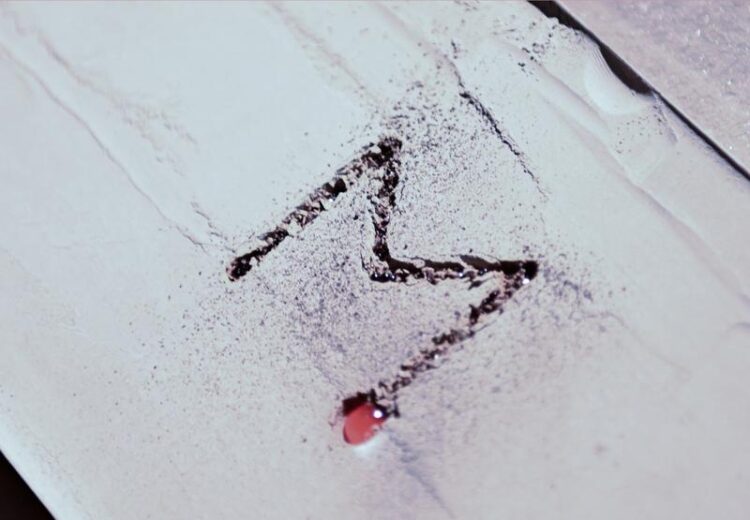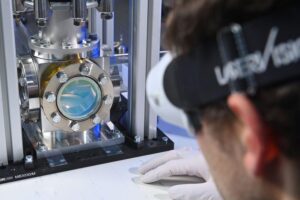MOONRISE: Step by step towards a village made of moon dust

First lanes as the basis for future building blocks made of moon dust - the MOONRISE project laid the foundation for this.
Photo: LZH
They are not yet usable as building blocks – but the lanes melted with the laser are a first step towards 3D-printed buildings, landing points, and roads made of moon dust. In the MOONRISE project, the team of scientists from the Institute of Space Systems (IRAS) at the Technical University of Braunschweig and the Laser Zentrum Hannover e.V. (LZH) have succeeded in both melting regolith under lunar gravity and “printing” joint lanes.
At the end of the two-year project funded by the Volkswagen Foundation, laboratory experiments were carried out with the MOONRISE laser on the IRAS rover’s robot arm. The scientists succeeded in melting moon dust into joint lanes. The robot arm controlled the laser head from the LZH, similar to how it could be used on the moon in the future,
Robust, small laser and moon-like regolith
“In the last two years, we have developed a laser head that is only about the size of a large juice box and yet can withstand the adverse conditions in space,” reports Niklas Gerdes, a scientific employee of the LZH, about the laser, which has already withstood the necessary temperature-vacuum and vibration tests. Niklas Gerdes summarises the next steps: “During the first tests in the laboratory, we determined the necessary irradiation duration and laser power. Then we went into the vacuum chamber and successfully melted regolith there.” The regolith used in the project comes from IRAS. Throughout the project, the regolith’s composition the IRAS scientists adapted it to the landing site’s expected conditions – a challenge that should not be underestimated. After all, the scientists have to find suitable materials on Earth based on data from past lunar missions to reproduce the lunar dust as accurately as possible.
Unique in the world: Regolith melted under lunar conditions in the Einstein Elevator

Photo: LZH
A highlight was the experiments in the Einstein-Elevator at Leibniz University Hannover (LUH). MOONRISE was the first-ever scientific experiment in the elevator. Prof. Dr.-Ing. Ludger Overmeyer, LUH/LZH, is still thrilled: “In the Einstein Elevator, we succeeded in melting regolith into spheres – both under complete weightlessness and under lunar gravity. That is unique in the world!”
A grand finale was the use of the laser on the IRAS rover MIRA3D. MIRA3D consists of a mobile platform and a robot arm and is used to develop additive manufacturing technology on the Moon. Prof. Dr.-Ing. Enrico Stoll from IRAS, TU Braunschweig, reports: “We were able to precisely control the laser head on the arm of the rover and thus melt larger structures precisely. A complete success! Together with the experiments in the elevator, we have a solid basis for 3D printing with the laser on the Moon.”
The next milestone after the project would be to develop the laser head into a flight model. LZH and IRAS are currently in talks with relevant agencies to push ahead with the developments. After all, with MOONRISE, the scientists have taken a big step closer to the vision of a laser that could print building materials for entire settlements from lunar dust.
About MOONRISE
The Volkswagen Foundation supported the ambitious and future-oriented research project within the now completed “Off the Beaten Track” funding initiative. The foundation supports extraordinary and daring projects for which no other financing can be found. The MOONRISE film depicts the idea behind the project and the progress.
Weitere Informationen:
https://www.lzh.de/en/publications/pressreleases/2021/moonrise-step-by-step-towa… press release on the website of the LZH with more photos
https://www.lzh.de/en/videos/moonrise-en Video of the MOONRISE project
Media Contact
All latest news from the category: Physics and Astronomy
This area deals with the fundamental laws and building blocks of nature and how they interact, the properties and the behavior of matter, and research into space and time and their structures.
innovations-report provides in-depth reports and articles on subjects such as astrophysics, laser technologies, nuclear, quantum, particle and solid-state physics, nanotechnologies, planetary research and findings (Mars, Venus) and developments related to the Hubble Telescope.
Newest articles

Compact LCOS Microdisplay with Fast CMOS Backplane
…for High-Speed Light Modulation. Researchers from the Fraunhofer Institute for Photonic Microsystems IPMS, in collaboration with HOLOEYE Photonics AG, have developed a compact LCOS microdisplay with high refresh rates that…

New perspectives for material detection
CRC MARIE enters third funding period: A major success for terahertz research: Scientists at the University of Duisburg-Essen and the Ruhr University Bochum have been researching mobile material detection since…

CD Laboratory at TU Graz Researches New Semiconductor Materials
Using energy- and resource-saving methods, a research team at the Institute of Inorganic Chemistry at TU Graz aims to produce high-quality doped silicon layers for the electronics and solar industries….



